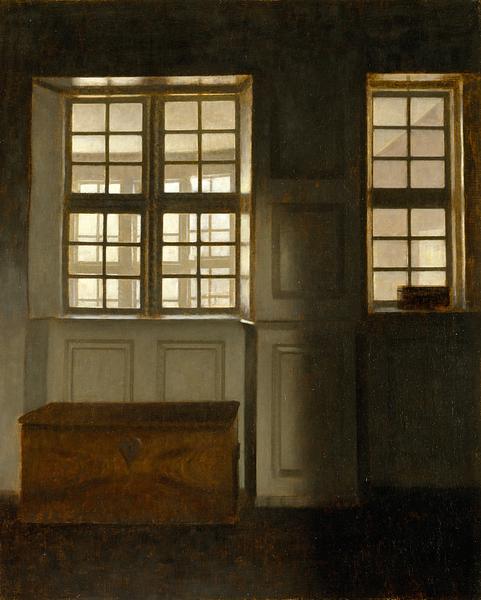In his home at Strandgade 30, Vilhelm Hammershøi was keenly interested in the many possibilities for working with light provided by the old flat’s rooms and layout. The floor plan was unusual, combining Late Baroque and Neoclassical features while boasting several small reception rooms, larger rooms and an exterior gallery, the latter being a later addition running along the façade between the two side wings of the house. Like the rest of the house, the windows of the gallery had small panes of glass mounted in distinctive glazing bars.
The composition of
Interior with a View of an Exterior Gallery is striking, because Hammershøi has sought to capture the shift in level and tone between the exterior gallery’s outer windows towards the courtyard and the inner windows opening on the living room. The result is a complicated interplay of windows, of light and darkness, of interior and exterior, all coming together to conjure up a distinctive, almost claustrophobic atmosphere where the room seems detached from its function as a place where people live.
Hammershøi’s placement of furniture in his interiors does not always seem logical, as is the case here, where the sturdy lidded chest marks a break in the structuring geometry of the white panels. Nevertheless, the chest conveys a sense of the room – or rather of the light falling in from the adjacent room. The closed, finite shape of the chest also contrasts with the windows, in which light from the outside world is revealed. As in
B 312, the windows are closed and offer no view of any world outside, giving us to sense that in this context, the inside is all that exists.
Inv. no. B 307
Published in:
Fortegnelse over arbejder af Vilhelm Hammershøi, [2], Kunstforeningen April-Maj 1916, København 1916, cat.no. 26, p. 5;
Sophus Michaëlis and Alfred Bramsen: Vilhelm Hammershøi. Kunstneren og hans værk, København 1918, cat.no. 240, p. 101;
Alfred Bramsen: Udvalg af Vilh. Hammershøis arbejder, København 1930, cat.no. 14, p. 8;
Erik Zahle: ”Billedkunst” in C.L. Davids Samling. Nogle Studier, [1], København 1948, p. 207;
Det besjälade rummet, Malmö Museum, Malmø 1975, p. 21;
Knud Voss and Verner Aspenström: Vilhelm Hammershøi, Prins Eugens Waldemarsudde, Stockholm 1976, cat.no. 21, p. 13;
Hanne Finsen, Inge Vibeke Raaschou-Nielsen: Vilhelm Hammershøi: en retrospektiv udstilling, Ordrupgaard, Charlottenlund 1981 Ordrupgaard, Charlottenlund 1981, cat.no. 87, p. 107;
Henrik Wivel: Symbolisme og impressionisme, København 1994, p. 107. (Nyere Dansk Kunsthistorie; 5);
Henrik Wivel: Vilhelm Hammershøi: dansk klassikerkunst, København 1996, fig. 17, pp. 35-36;
Bente Scavenius and Jens Lindhe: Hammershøis København, Kunstforeningen GL STRAND, København 2003, pp. 62-63;
Poul Vad: Hammershøi. Værk og liv, København 2003, 5. ed., pp. 119-121;
Tone Sinding Steinsvik, Ida Lorentzen, Bente Scavenius: Den forunderlige stillheten: Ida Lorentzen (f.1951), Vilhelm Hammershøi (1864-1916), Stiftelsen Modums Blaafarveværk, Modum 2005, cat.no. 56, pp. 91, 94;
Annette Rosenvold Hvidt (ed.): Hammershøi – Dreyer: Billedmagi, Ordrupgaard, Charlottenlund 2006, cat.no. 14, pp. 70, 93;
Felix Krämer, Naoki Sato and Anne-Birgitte Fonsmark: Hammershøi, Royal Academy of Arts, London 2008, cat.no. 38, s. 108, 151;
Kasper Monrad et al.: Hammershøi og Europa, Statens Museum for Kunst, København 2012, cat.no. 79, pp. 98, 103;
Anne-Birgitte Fonsmark, Jacob Bach Riis (eds.): Hjemme hos Hammershøi, Ordrupgaard, Charlottenlund 2016, cat.no. 65, fig. 35, pp. 40-41 and fig. 101, pp. 112-113;
Henrik Wivel: Hammershøi i Davids Samling, København 2017, pp. 70-71;
Annette Rosenvold Hvidt and Gertrud Oelsner: Vilhelm Hammershøi. På sporet af det åbne billede, København 2018, pp. 348-349;
Annette Rosenvold Hvidt and Gertrud Oelsner (eds.): Fremkaldelser. Vilhelm Hammershøi, Valdemar Schønheyder Møller og fotografiet, Den Hirschsprungske Samling, København 2021, ill. no. 129, pp. 141, 143;
